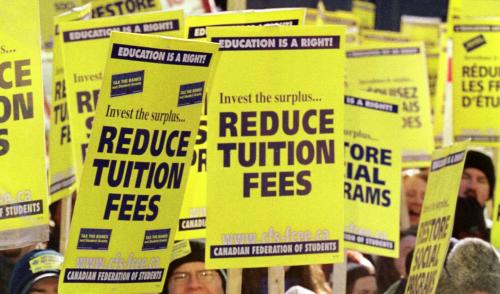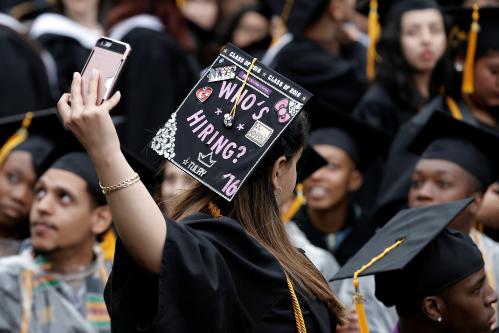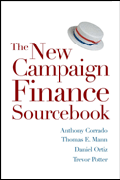Roughly seven million borrowers are in default on their federal student loans, and a record amount of outstanding student loan debt is delinquent. There is a well-publicized concern that student loan default will hinder economic growth and harm students for years to come. Policymakers have responded to this worry with a wave of proposed legislation and regulatory rulemaking related to student loan repayment, and also have produced broader proposals to reform the structure of higher education finance.
An important, but less frequently considered part of this policy discussion is how student loans are treated in bankruptcy proceedings. This has become a greater concern now that so many borrowers are having difficulty repaying their student loan debt, and will therefore demand attention even if student loan programs are overhauled. The crux of the issue is that student loans are nondischargeable barring narrow circumstances, which means that borrowers are obligated to repay educational debt even after declaring bankruptcy. Recent proposals attempt to reverse nondischargeability laws, but would making student loans dischargeable in bankruptcy lead to more defaults?
The debate over dischargeability
The policy debate is populated by conflicting views: some claim the incentives to abuse the bankruptcy system are high and threaten the survival of student loan programs, while others believe the incidence of opportunism is trivial and therefore does not merit the burden that nondischargeability imposes on struggling debtors.
U.S. bankruptcy laws provide the “honest but unfortunate” debtor with an opportunity to rebuild financially after experiencing hardship. Bankruptcy is costly to lenders since it lowers the return expected on disbursed funds. Bankruptcy is also costly to debtors since it harms credit scores and makes it more difficult to borrow in the future. Nonetheless, bankruptcy can have many benefits when used judiciously. Most consider it essential to credit market operations because it arbitrates creditor claims against the borrower. Bankruptcy also promotes debtors’ post-bankruptcy productivity by giving them the opportunity to start anew, unburdened by pre-existing debt.
Some policymakers have long feared that many student loan borrowers who declare bankruptcy are neither honest, nor unfortunate. As a result, federal student loans have been considered nondischargeable since the 1970s, and bankruptcy reform in 2005 extended nondischargeability to private student loans.
Therefore, most student loan borrowers cannot enjoy the full extent of relief from bankruptcy because they retain the responsibility to repay educational debt. There are hardship exceptions to nondischargeability laws, but the appeals process has been criticized for being arbitrary and can be expensive and arduous.
Why are student loans treated differently in bankruptcy? In the past, debtors could clear their student loan debt in bankruptcy by surrendering their assets. However, new college graduates often own few assets to give up, even though they have high expected future incomes. As a result, the concern is that opportunists could game the system by running up large debts that they never plan to repay because they can declare bankruptcy on the eve of starting lucrative careers.
Without restrictions to guard against this moral hazard, lawmakers argued that student loans would be ripe for fraud, i.e., too easily discharged in bankruptcy. This could ultimately reduce the availability of educational credit and possibly even destroy student loan programs. The unique nature of student loans complicates actions that guard against this behavior. Borrowers don’t place collateral against their educational debt and the interest rates that borrowers are charged often either do not fully reflect their default risk or are not risk-priced at all.
Evidence from bankruptcy filings
To shed light on this debate, a colleague and I analyzed millions of anonymized credit bureau records to examine whether bankruptcy filing behavior changed following the 2005 law that made private student loan debt nondischargeable. The private student loan market is estimated to account for around $150 billion out of $1.2 trillion in outstanding student loan debt. The private student loan market, in particular, is the target of recent legislative proposals that attempt to roll back nondischargeability. This is because, unlike federal programs that are subsidized by taxpayers and where the public would be responsible for covering costs associated with default, private lenders can incorporate risk into the terms of their student loans. Compounding criticisms about private student loan nondischargeability are claims that these provisions were snuck into the 2005 legislation without proper vetting.
If private student loan debtors were behaving opportunistically pre-policy, we would have expected a sharp relative decline in bankruptcy filings after the 2005 provision impeded their alleged opportunistic behavior, as compared to debtors whose incentives were not directly affected by the nondischargeability provision. Yet, we do not find evidence of such a reduction. In other words, our analysis does not reveal responses to the 2005 bankruptcy reform that would indicate widespread opportunistic behavior by private student loan borrowers before the policy change. Our findings do not eliminate the possibility that some filers were gaming the bankruptcy system, but we do not find that the behavior was pervasive.
Potential reforms
As long as student debt is restricted from being discharged in bankruptcy, it will carry with it amplified financial risk since struggling students may not be able to obtain the “fresh start” the bankruptcy system aims to provide. This risk is particularly concerning since new analysis indicates that those most likely to default on their student loans are relatively vulnerable—more likely to be from low-income families and live in poorer neighborhoods and less likely to complete their postsecondary programs and gain a well-paying job.
Our analysis suggests that policymakers might not need to worry so much about the potential for misuse of the bankruptcy system; however, it also indicates that the 2005 nondischargeability policy change increased the availability of student loan credit. Therefore, if nondischargeability laws were rolled back, it is likely that private student loans would be less accessible and more expensive for many borrowers. There is ample concern that students who currently rely heavily on private loans may not be making informed decisions, since these loans typically have less attractive terms than do federal loans. Nonetheless, private student loans have been used to cover financial needs that are unmet by public programs and to offset the lack of access to federal lending programs at some schools, including at many community colleges.
The expected reduction in credit availability may make policymakers reticent to wholly repeal student loan nondischargeability laws. If so, the establishment of clear and accessible guidance on the standards that debtors must meet in order to obtain an undue hardship exception could represent an improvement. The need to appeal will still present a substantial barrier to many struggling student debtors, and thus policymakers might also consider supports that facilitate hardship appeals among those that are deserving.










Commentary
Should student loans be dischargeable in bankruptcy?
September 29, 2015